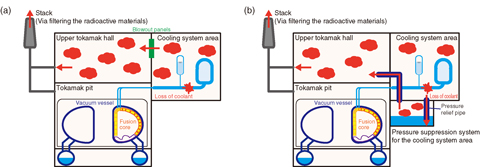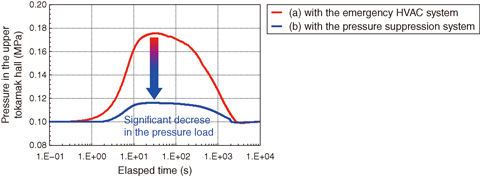
Fig.9-19 Strategies to maintain the integrity of the final confinement barrier for radioactive materials in a loss-of-coolant accident

Fig.9-20 Transient behaviors of the fusion DEMO systems under a loss-of-coolant accident, clarified by thermohydraulic analysis
Fusion reactors involve radioactive materials like tritium as fusion fuel and radioactive products due to irradiation by fusion neutrons. If an accident occurs, progression of the accident must be prevented and functions for confinement of the radioactive materials must be ensured. Safety research is being conducted now by JAEA, aiming to establish safety design guidelines for the conceptual design of the fusion demonstration (DEMO) reactor. We postulate a variety of accident situations, and analyze the responses of DEMO systems to such accidents. The accident analyses allow us to identify the safety characteristics of the DEMO in accident situations. We are also studying systems for the prevention of accident progression and for mitigation of accident consequences.
Ex-vessel loss-of-coolant accidents (LOCAs) are postulated to be of importance for the safety of the fusion DEMO reactor. Water, which is used for cooling the in-vessel components and electricity generation, is maintained under conditions of a pressure of 15.5 MPa and a temperature of 290−325 ℃; these conditions are similar to those of light water nuclear reactors (pressurized water reactors; PWRs). If a cooling pipe is broken, the water generates a large pressure load to the building constituting the final confinement barrier, and the building may suffer breaks. A key issue addressed here is whether the fusion DEMO reactor will need a pressure-tight area like the containment building of PWRs.
We have analyzed the thermohydraulic response of the fusion DEMO reactor to the ex-vessel LOCA and assessed the effectiveness of strategies to mitigate the pressure load on the building. We conservatively assumed a double-ended break of a cooling pipe in the analysis, which is considered to hardly ever occur. We considered two confinement strategies Fig.9-19(a) use of the emergency heating, ventilating, air conditioning (HVAC) system, and Fig.9-19(b) use of the emergency HVAC system and the pressure suppression system for the cooling system area. The results of the thermohydraulic analysis (Fig.9-20) indicate that use of the pressure suppression system for the cooling system area will significantly decrease the pressure load upon the upper tokamak hall, which constitutes the final confinement barrier for radioactive materials and has a large volume for maintenance of in-vessel components. If the strategy (b) is chosen, the volume of the cooling system vault, which is pressure tight, is three times smaller than the typical volume of a PWR containment building.
We have thus found that the integrity of the final confinement barrier can be maintained by a combination of the use of the area for the intrinsic purposes, i.e., maintenance, with proper segregation of the confinement areas. Although the fusion DEMO reactor will need a pressure-tight area, its volume is relatively small. This finding is important for establishing a concept to confine the radioactive materials by the final barrier.